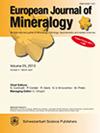天然金红石中H+与微量元素偶联取代的原位定量评价框架
IF 1.7
3区 地球科学
Q2 MINERALOGY
引用次数: 0
摘要
摘要利用原位偏振傅立叶变换红外光谱(FTIR)和激光烧蚀电感耦合等离子体质谱(LA–ICP–MS)分析研究了金红石中H+和微量元素的耦合行为。金红石中的H2O含量可以通过对单个晶粒的原位偏振FTIR测量精确地定量。与传统的定量方法相比,这种新方法的好处是保留了金红石中水的结构背景和不均匀性。来自六种不同地质环境的金红石显示H2O含量在~ 50–2200 µg g−1,对于H2O含量在~ 500和~ 2200 µg g−1.根据FTIR峰去卷积,在~ 3280,~ 3295,~ 3324,~ 3345,~ 3370和 3390 cm−1,这可能与分别与Ti3+、Fe3+、Al3+、Mg2+、Fe2+和Cr2+的偶联取代有关。榴辉岩样品中的金红石显示出Ti4的主要交换反应+ → Ti3+、Fe3+ + H+,其中白片岩中的金红石主要显示Ti4+ → Al3+ + H+。与微量元素相关的H+含量与LA–ICP–MS微量元素数据相结合,揭示了H+对电荷平衡和微量元素与三价阳离子偶联的重要意义。三价阳离子是金红石中最丰富的杂质,并且没有足够的H+和五价阳离子(如Nb和Ta)来实现完全的电荷平衡,这表明需要额外的氧空位来实现三价阳离子的电荷平衡。多价微量元素的价态可以从去卷积FTIR光谱中推断出来。钛出现在0.03 ‰–7.6 ‰ 与Fe2+和Cr2+相比,Ti3+、Fe和Cr优选以Fe3+和Cr3+的形式引入,并且V最有可能以V4+的形式出现。这开启了金红石中H+作为变质和俯冲带流体氧逸度的潜在指标的可能性,其中与Ti3+和Fe3+相关的H+含量之比最有希望。本文章由计算机程序翻译,如有差异,请以英文原文为准。
A framework for quantitative in situ evaluation of coupled substitutions between H+ and trace elements in natural rutile
Abstract. The coupling behaviour of H+ and trace elements in rutile has been
studied using in situ polarised Fourier transform infrared (FTIR)
spectroscopy and laser ablation inductively coupled plasma mass spectrometry
(LA–ICP–MS) analysis. H2O contents in rutile can be precisely and
accurately quantified from polarised FTIR measurements on single grains in
situ. The benefits of this novel approach compared to traditional
quantification methods are the preservation of textural context and
heterogeneities of water in rutile. Rutile from six different geological
environments shows H2O contents varying between ∼ 50–2200 µg g−1, with large intra-grain variabilities for vein-related samples
with H2O contents between ∼ 500 and
∼ 2200 µg g−1. From FTIR peak deconvolutions, six distinct
OH absorption bands have been identified at ∼ 3280, ∼ 3295, ∼ 3324,
∼ 3345, ∼ 3370, and
∼ 3390 cm−1 that can be related to coupled substitutions
with Ti3+, Fe3+, Al3+, Mg2+, Fe2+, and Cr2+,
respectively. Rutile from eclogite samples displays the dominant exchange
reactions of Ti4+ → Ti3+, Fe3+ + H+, whereas
rutile in a whiteschist shows mainly Ti4+ → Al3+ + H+.
Trace-element-dependent H+ contents combined with LA–ICP–MS
trace-element data reveal the significant importance of H+ for charge
balance and trace-element coupling with trivalent cations. Trivalent cations
are the most abundant impurities in rutile, and there is not enough H+
and pentavalent cations like Nb and Ta for a complete charge balance,
indicating that additionally oxygen vacancies are needed for charge
balancing trivalent cations. Valance states of multivalent trace elements
can be inferred from deconvoluted FTIR spectra. Titanium occurs at 0.03 ‰–7.6 ‰ as Ti3+, Fe, and Cr are preferentially
incorporated as Fe3+ and Cr3+ over Fe2+ and Cr2+, and V
most likely occurs as V4+. This opens the possibility of H+ in rutile as
a potential indicator of oxygen fugacity of metamorphic and subduction-zone
fluids, with the ratio between Ti3+- and Fe3+-related H+
contents being most promising.
求助全文
通过发布文献求助,成功后即可免费获取论文全文。
去求助
来源期刊
CiteScore
2.80
自引率
9.50%
发文量
40
审稿时长
6-12 weeks
期刊介绍:
EJM was founded to reach a large audience on an international scale and also for achieving closer cooperation of European countries in the publication of scientific results. The founding societies have set themselves the task of publishing a journal of the highest standard open to all scientists performing mineralogical research in the widest sense of the term, all over the world. Contributions will therefore be published primarily in English.
EJM publishes original papers, review articles and letters dealing with the mineralogical sciences s.l., primarily mineralogy, petrology, geochemistry, crystallography and ore deposits, but also biomineralogy, environmental, applied and technical mineralogy. Nevertheless, papers in any related field, including cultural heritage, will be considered.

 求助内容:
求助内容: 应助结果提醒方式:
应助结果提醒方式:


